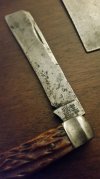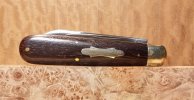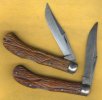This may be a rather long post for the thread but I do know there is a great appreciation for old knives here and this is one with an interesting historical story as well … The phrase “Buy the knife not the story” doesn’t apply to this particular example - I bought both 
Thomaston Knife Co MOP Whittler – A Special Knife with a PKBG&F National Union Label
Without a doubt this Thomaston Knife Co (1884-1930) MOP Whittler with a unique etch and tang stamp from a long gone cutlery union certainly caught my attention immediately when it was shown to me by my good friend Steve Pfeiffer (knifeaholic on the forum and author of Collecting Case Knives: Identification and Price Guide). Steve kindly sold me this knife to my excitement (TU) and it is important to note the knife was part of his Dad’s collection for many years – Steve’s Dad was an avid collector and found this knife back in the 1970s at an antique mall in Iowa of all places – a very special knife indeed from many standpoints and with many stories!! The historical background related to the cutlery union noted on the knife “PKBG&F – Pocket Knife Blade Grinders & Finishers” is indeed quite interesting - see photos and information below that just highlights some of my findings to date.
Information regarding the PKBG&F Union is somewhat obscure. Historical background and a perspective on American cutlery unions was noted in the 1955 thesis of Martha Taber from Smith College in Northhampton MA (The Cutlery Industry of the CT River Valley) though she does not mention this particular union. Taber conveyed a good account of unionization though it was also noted that little in-depth records exist as to the history and details of the cutlery unions. I have uncovered further information through extensive internet searching that augmented that found in Martha Taber’s thesis noted above. At the present I am trying to determine if contacting and/or visiting certain government sectors responsible for record keeping and/or historical organizations will reveal more background.
In brief - The American Cutlery Industry went through a period of unionization from approximately 1884 until 1917 and was first organized under the Knights of Labor. Unions had long been known to German and British cutlery workers but little was organized in the USA until the mid 1880s. Sheffield cutlery unions were initiated as early as the late 1700s and continued into the 1900s so the principle and benefit of these work associations were not a new concept (though in truth these unions struggled to be successful in labor disputes). Keep in mind that many cutlers emigrated to the USA from Sheffield and Germany to the Northeast so protection through organized labor associations was not new to them. In the USA beginning in the mid 1800s there is some record of cutlery workers “striking”” though these early attempts of an unorganized labor force were not successful. In particular it appears the Grinders (& Polishers or Finishers) of the industry were known to be in a sense the “strength” of knife making and the early unionized efforts were focused upon protecting these cutlery workers – remember without their expertise there would not be any knives made. Indeed the employers of the cutlery industry struggled with unionization but among cutlery employers there were some agreements not to hire workers from other companies. For example The John Russell Co had an agreement with Landers Frary & Clark not to employ each others workers. These employer agreements predated the formal American Cutlery Unions such as the PKBG&F.
Nonetheless this knife with the PKBG&F etch and label is the only example to my knowledge and also to those with many more years of collecting than I that I have made aware of this knife to date. Though the knife was made by the Thomaston Knife Co with the PKBG&F etch and stamp including union label, it is important to point out that Thomaston was not the only cutlery company that was unionized. I have not found a listing of companies which did participate in the PKBG&F Union but I did find the following from the Proceedings of the American Federation of Labor in 1906 which clearly suggests other companies did participate: “The PKBG&F National Union believe that by the use of this label fair manufacturing firms engaged in the production of pocket knives will receive great benefit by its use, that the firms now considered unfair will be brought into harmony with our craft and a most effective blow will be given all such firms such as may exist which produce unfair pocket knives - and - We believe the manufacturers have combined to keep this label off the market with the exception of a small number”. According to the published proceedings the union label was thus registered and supported by the American Federation of Labor in 1906. Thus the PKBG&F National Union seemed to not only protect workers rights though that is not entirely clear but certainly was designed to protect companies that practiced fair manufacturing. In 1917 the PKBG&F was disbanded for an unknown reason to me based on my research to date. However background research did reveal most of the membership was taken up by the Metal Polishers Union in 1917.
A major question is “Was this a marketed knife for the public or only made for unionized employers & employees?”. The above information suggests this knife was possibly made for general distribution and sale based on the notation in the American Federation of Labor proceedings and resolutions from 1906 where the label was approved to promote knives of unionized companies, ie my interpretation was buy union knives and not the competition’s knives who are not practicing fair market and production values. Alternatively the knife was made for unionized companies and employees. Whether this knife was widely sold and distributed or was only possessed by union members remains an unknown at this time.
The knife is a MOP Crown Whittler in lightly used condition (no signs of any sharpening) and is 3” closed. Note the photos below of the blade etch and the pile side tang stamp which depicts the union marks and label. The etch on the blade not only notes Grinders & Finishers but underneath is an etch of a blade with a Union Label (the latter being the approved registered mark as presented by the PKBG&F to the American Federation of Labor in 1906). The blade with Union Label also appears under the pile side tang stamp (PKBG&F) and underneath the blade with Union Label is REG which means it was a registered label. Given that background I believe the knife was made between 1906 and 1917. Again the PKBG&F Union disbanded in 1917 as noted above (though Thomaston remained in business until 1930).
At this point my research continues and I have a few other details and leads. Importantly any forum members who have any further information on their knowledge of cutlery unions and notably any knives that depict any union labels would be of great help and interest. Clearly as noted above the Thomaston Knife Co was not the only member of the PKBG&F National Union so perhaps somebody may possess another union knife from another cutlery. Members who collect knives of a specific company that were in the time frame noted may have further info. I am considering writing a few different articles that would incorporate the knife & historical background and in fact submitted a proposal for approval. I will certainly credit any folks who provide significant information to be included or other examples of “union” stamped knives.
Nonetheless any helpful information would be much appreciated and of course comments etc !! Thanks to all!!
Cheers!
Lee
Mark Side:

Pile Side:

Knife with Blades Open:

Blade Etch Closeup:

Pile Side Tang Stamp:

Mark Side Tang Stamp:

Springs:

Thomaston Knife Co MOP Whittler – A Special Knife with a PKBG&F National Union Label
Without a doubt this Thomaston Knife Co (1884-1930) MOP Whittler with a unique etch and tang stamp from a long gone cutlery union certainly caught my attention immediately when it was shown to me by my good friend Steve Pfeiffer (knifeaholic on the forum and author of Collecting Case Knives: Identification and Price Guide). Steve kindly sold me this knife to my excitement (TU) and it is important to note the knife was part of his Dad’s collection for many years – Steve’s Dad was an avid collector and found this knife back in the 1970s at an antique mall in Iowa of all places – a very special knife indeed from many standpoints and with many stories!! The historical background related to the cutlery union noted on the knife “PKBG&F – Pocket Knife Blade Grinders & Finishers” is indeed quite interesting - see photos and information below that just highlights some of my findings to date.
Information regarding the PKBG&F Union is somewhat obscure. Historical background and a perspective on American cutlery unions was noted in the 1955 thesis of Martha Taber from Smith College in Northhampton MA (The Cutlery Industry of the CT River Valley) though she does not mention this particular union. Taber conveyed a good account of unionization though it was also noted that little in-depth records exist as to the history and details of the cutlery unions. I have uncovered further information through extensive internet searching that augmented that found in Martha Taber’s thesis noted above. At the present I am trying to determine if contacting and/or visiting certain government sectors responsible for record keeping and/or historical organizations will reveal more background.
In brief - The American Cutlery Industry went through a period of unionization from approximately 1884 until 1917 and was first organized under the Knights of Labor. Unions had long been known to German and British cutlery workers but little was organized in the USA until the mid 1880s. Sheffield cutlery unions were initiated as early as the late 1700s and continued into the 1900s so the principle and benefit of these work associations were not a new concept (though in truth these unions struggled to be successful in labor disputes). Keep in mind that many cutlers emigrated to the USA from Sheffield and Germany to the Northeast so protection through organized labor associations was not new to them. In the USA beginning in the mid 1800s there is some record of cutlery workers “striking”” though these early attempts of an unorganized labor force were not successful. In particular it appears the Grinders (& Polishers or Finishers) of the industry were known to be in a sense the “strength” of knife making and the early unionized efforts were focused upon protecting these cutlery workers – remember without their expertise there would not be any knives made. Indeed the employers of the cutlery industry struggled with unionization but among cutlery employers there were some agreements not to hire workers from other companies. For example The John Russell Co had an agreement with Landers Frary & Clark not to employ each others workers. These employer agreements predated the formal American Cutlery Unions such as the PKBG&F.
Nonetheless this knife with the PKBG&F etch and label is the only example to my knowledge and also to those with many more years of collecting than I that I have made aware of this knife to date. Though the knife was made by the Thomaston Knife Co with the PKBG&F etch and stamp including union label, it is important to point out that Thomaston was not the only cutlery company that was unionized. I have not found a listing of companies which did participate in the PKBG&F Union but I did find the following from the Proceedings of the American Federation of Labor in 1906 which clearly suggests other companies did participate: “The PKBG&F National Union believe that by the use of this label fair manufacturing firms engaged in the production of pocket knives will receive great benefit by its use, that the firms now considered unfair will be brought into harmony with our craft and a most effective blow will be given all such firms such as may exist which produce unfair pocket knives - and - We believe the manufacturers have combined to keep this label off the market with the exception of a small number”. According to the published proceedings the union label was thus registered and supported by the American Federation of Labor in 1906. Thus the PKBG&F National Union seemed to not only protect workers rights though that is not entirely clear but certainly was designed to protect companies that practiced fair manufacturing. In 1917 the PKBG&F was disbanded for an unknown reason to me based on my research to date. However background research did reveal most of the membership was taken up by the Metal Polishers Union in 1917.
A major question is “Was this a marketed knife for the public or only made for unionized employers & employees?”. The above information suggests this knife was possibly made for general distribution and sale based on the notation in the American Federation of Labor proceedings and resolutions from 1906 where the label was approved to promote knives of unionized companies, ie my interpretation was buy union knives and not the competition’s knives who are not practicing fair market and production values. Alternatively the knife was made for unionized companies and employees. Whether this knife was widely sold and distributed or was only possessed by union members remains an unknown at this time.
The knife is a MOP Crown Whittler in lightly used condition (no signs of any sharpening) and is 3” closed. Note the photos below of the blade etch and the pile side tang stamp which depicts the union marks and label. The etch on the blade not only notes Grinders & Finishers but underneath is an etch of a blade with a Union Label (the latter being the approved registered mark as presented by the PKBG&F to the American Federation of Labor in 1906). The blade with Union Label also appears under the pile side tang stamp (PKBG&F) and underneath the blade with Union Label is REG which means it was a registered label. Given that background I believe the knife was made between 1906 and 1917. Again the PKBG&F Union disbanded in 1917 as noted above (though Thomaston remained in business until 1930).
At this point my research continues and I have a few other details and leads. Importantly any forum members who have any further information on their knowledge of cutlery unions and notably any knives that depict any union labels would be of great help and interest. Clearly as noted above the Thomaston Knife Co was not the only member of the PKBG&F National Union so perhaps somebody may possess another union knife from another cutlery. Members who collect knives of a specific company that were in the time frame noted may have further info. I am considering writing a few different articles that would incorporate the knife & historical background and in fact submitted a proposal for approval. I will certainly credit any folks who provide significant information to be included or other examples of “union” stamped knives.
Nonetheless any helpful information would be much appreciated and of course comments etc !! Thanks to all!!

Cheers!
Lee
Mark Side:

Pile Side:

Knife with Blades Open:

Blade Etch Closeup:

Pile Side Tang Stamp:

Mark Side Tang Stamp:

Springs:









